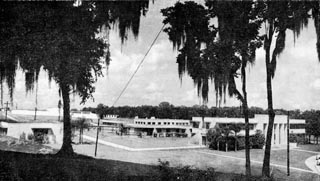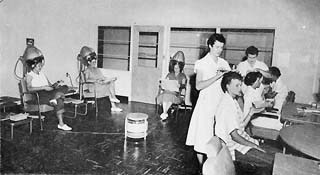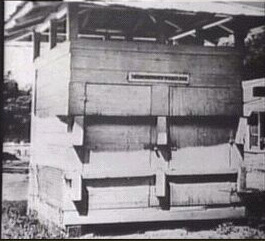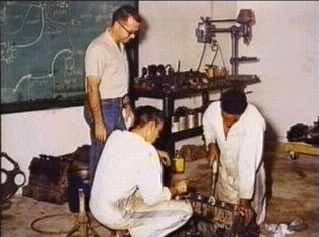1956
INMATE POPULATION DECEMBER 31, 1956: 5,107
The first women's prison, Florida Correctional Institution, is constructed at Lowell, Florida. Raiford's female prisoners are transferred to the new facility.

Florida Correctional Institution, Lowell, Florida

The beauty parlor at Lowell C.I. serves the dual purpose of training inmates in hair care and providing a "perk" to deserving inmates by allowing them to have their hair done on occasion.
1957
INMATE POPULATION JUNE 30, 1957: 5,624
Florida adopts a new Correctional Code, establishing the Division of Corrections. R.O. Culver is appointed the first director of the Division of Corrections on July 1, 1957 and will remain in office until April 1959. General philosophy changes from "punishment" to "correction." Prior to officially beginning his new Director job, Culver reviewed the state of the correction system in Florida and had several suggestions that could have been equally applicable in the decades since he wrote this letter.
CULVER'S SUGGESTIONS
Tallahassee, Florida
Room 122 – Capitol
December 31, 1956
Honorable Leroy Collins
Governor of Florida
Capitol
Dear Governor Collins:
While I have not as yet had the time or opportunity to make a complete survey of all the Florida Penal and Correctional Institutions, I have visited and inspected a representative number of places of confinement including the School for Boys at Marianna, the Apalachee Correctional Institution at Chattahoochee, several prison camps, Raiford, the Prison for Women at Lowell, the White Girls School at Ocala, the Colored Girls School at Lowell, and Glades State Prison Farm at Belle Glade. I feel that I am now ready to submit to you a report covering what I have observed and my preliminary recommendations.
By and large, I found the institutions visited well administered and the employees loyal, cooperative, and possessing an earnest and sincere desire to assist in developing the Florida Penal System into an organization, modern, effective, and efficient.
For the most part the institutions have well planned and constructive work and rehabilitative programs. There are instances, of course, where the programs could, and should, be expanded and additional industries established to provide a realistic and constructive work program for a rapidly expanding prisoner population.
It is true the Florida Penal System has not kept pace with the steady growth and advancements made by some of the other State agencies but I have found nothing of particular importance wrong with the prisons that cannot be corrected with a program of close cooperation and coordination between institutions and a well thought out plan of operations. And in the development of a plan may I suggest, for the present, a program be adopted dealing with two phases of operations:
- An Immediate Program, and
- A Long Range Program.
IMMEDIATE PROGRAM:
- Establish Classification and Assignment System.
- Relieve over-crowded conditions.
- Secure expert advice and estimates as to cost of establishing sufficient housing to take care of the prison population in the foreseeable future.
- Secure services of dis-interested Medical Officers to advise on what is needed by way of medical, surgical, psychiatric, and dental services in the Prison System.
- Establishment of a system of Classification and Assignment
should be accomplished as soon as possible. This would
consist of a committee whose duty it would be to gather
pertinent information concerning prisoners, their back-
ground, home situations and environment, their mental
and physical status, whether or not they are good, or
poor, custodial risks, determine their educational
qualifications and other related matter, and make rep-
resentations and recommendations to the warden or
superintendent as to who should, and who should not
be considered for transfer to Medium or Minimum Security
camps and farms.
This Classification and Assignment Committee should be Headquartered at Raiford and would be composed largely Of department heads already employed at Raiford and if they possess necessary qualifications such as: the Supervisor of Education, the Chief Medical Officer, a member of the Parole and Welfare Department, (who should be a qualified psychologist), the Deputy Warden, or Assistant Superintendent, Captain of the Guards, and Chaplain.
- Practically all our institutions have an urgent need for
additional housing facilities for prisoners. Raiford
has a particular need for immediate relief, their population
is at least twice as large as it should be for efficient
operation. In some instances there are eighteen men in
one cell that should be occupied by a maximum of six.
This is indeed a serious situation and on that immediate steps should be taken to correct. My recommendation, as a means of combating these over-crowded conditions, is to establish camps, or prisons, of a temporary nature as quickly as possible, to be populated by some of the older, more trustworthy, and infirm prisoners.
- Over-crowding, lack of adequate work programs and the absence
of sufficient leisure time activities are some of the most
important problems faced by prison administrators. The
Florida Penal Institutions are over-crowded, a fact that
has been established, and both the work, and leisure
time activities programs are not what they should be largely
because of lack of housing space; therefore, it is recommended
that we start, as quickly as possible, to perfect plans for
the construction of adequate housing facilities to take care
of the rapidly expanding prison population by the employment
of a competent firm of architects to work closely with the
Coordinator of Institutions and the Director of Prisons in
arriving at what would be the correct type of institution,
or institutions, to construct and the approximate cost
of the structure chosen. I would suggest that we start
this project immediately in order that a realistic figure
and justification therefore may be presented at the coming
meeting of the Legislature.
- I believe the fact is pretty well established that the Medical, Surgical, Psychiatric, and Dental Services at some of our institutions, especially Railford, are inadequate. Not being trained in these services personally, may I suggest that we secure the help of at least two dis-interested Medical Doctors to survey the situation and recommend just what is needed in the way of personnel to staff our hospitals and dental clinics. And may I suggest that the Doctors making the survey be men with training in the operation of institution hospitals and clinics. (This shortage of medical personnel is an extremely serious situation and one that should be elevated as expeditiously as possible.)
LONG RANGE PROGRAM:
A Long Range Program is something that has to do with every phase of prison operations and I am sure many important items will be unavoidably omitted if I start to enumerate them; however, I will try to mention a few of the more prominent activities to be considered in establishing a modern and up to date penal system:
- No small part of an efficient and effective program is the Recruitment and Training of intelligent and dependable personnel to perform the manifold and oftentimes complex duties of prison officers and employees.
- In keeping with the recruitment of intelligent and depend- able personnel, we should strive to develop within our Prison Service a system of promotions whereby a man can reach the top positions through diligence, dependence, intelligence and perseverance. (The Prison Service should be indeed a Career Service).
- Develop "Job Descriptions" for each position in the Prison Service.
- Adopt standardized Wage Scales that would apply to jobs of a like nature in all institutions.
- Establish new industries and expand old ones in order to furnish sufficient work programs for all prisoners.
- Establish definite areas of responsibility in the various institutions for specialized activities, such as medical educational, business, custodial, farm, industries, welfare- classification-parole, mechanical and maintenance, training- personnel, religion.
- Implement a realistic vocational training program, as well as academic, for all inmates who are mentally and physically capable of absorbing instructions of an educational nature, either on the job or in the class room.
- A program of preventative maintenance should be a "must" at all institutions and other "good housekeeping" practices should be stressed in the interest of appearances, san- itation, and economy.
- Considerable improvement can be shown in the culinary departments of some of our institutions and at the same time improve the preparation of food and train the inmates as cooks, bakers, and waiters, jobs that are always avail- able and might very well be the means of keeping a man out of a prison after his release.
These are but a few of the very important aspects of prison work that must be given consideration if we are to develop our Penal and Correctional System into a modern, and efficient organization.
R.O. Culver
Director Florida Penal System
Avon Park Correctional Institution opens.
The first Classification Staff are hired at Florida State Prison and a card system for inmate records is implemented.

Central Office for the Division of Corrections is located in Tallahassee. Aerial view of the State Capitol in Tallahassee, Florida.
1958
INMATE POPULATION JUNE 30, 1958: 6,342
Florida State Prison's "O Unit," a maximum security unit, opens.
The use of sweat boxes ends. According to former Road Prison Director, L.W. Griffith, many inmates stayed in the sweat boxes for a minimum of 10 days. They were given a half pound of cornbread and water. The box was 6' x 3', and if two were in it, they could not lay down to sleep.
Prisons emphasize rehabilitation, not punishment.

The use of sweat boxes as a form of punishment ends.
1959
INMATE POPULATION JUNE 30, 1959: 6,872
On July 2, 1959, H.G. Cochran, Jr. is appointed Director of the Division of Corrections, replacing R.O. Culver. He will remain in this position until 1962.

H.G. Cochran, Director
Division of Corrections
First Transition Officers are hired to assist inmates with placement upon release.
A male unit opens at Florida Correctional Institution. Apalachee Correctional Institution's West Unit opens. Marion Correctional Institution and Caryville Work Camp are established.
Two years after his release Clarence Martin is arrested and sentenced to 10 years for breaking and entering. He begins his 7th incarceration at age 58.
 |
|
1960
INMATE POPULATION JUNE 30, 1960: 6,989
New six-digit numbering system to identify inmates is implemented.
1961
INMATE POPULATION JUNE 30, 1961: 7,536
Florida State Prison, East Unit, a new maximum security unit, is constructed in Starke. Construction continues after the prison opens and is not completed until the late 1960s. In 1972, when the units of Florida State Prison are split into two institutions, this unit becomes today's Florida State Prison.
The official newsletter of the Florida Division of Corrections, the Correctional Compass, makes its debut. The following is an excerpt from the original "Correctional Compass" newsletter, from September 1, 1961. It is written by then-Director of the Florida Division of Corrections H.G. Cochran, Jr.
CORRECTIONAL COMPASS
"I am going to use this first issue of the Division's newsletter to call to the attention of all employees the urgent need for training in the area of Civil Defense. Most of you are aware of the gravity of the present world situation, especially in view of recent developments in the Berlin crisis. Maintaining a state of constant preparedness is our best defense for survival in the event there is an outbreak of hostilities resulting from nuclear attacks. However, Civil Defense training is not restricted to survival training for nuclear attacks, but it is survival training for any form of a disaster, natural or man-made.
This training is valuable to all of us by preparing us for any emergency that might develop. At the requests of your superintendents, the Personnel Officers in your institutions are currently in the process of establishing Civil Defense classes so that each employee in the institution will have an opportunity to avail himself of this training. When you are called upon to participate in one of these classes, do so willingly because it may mean the difference to you and your family of surviving or not surviving in a natural disaster or nuclear attack."
On October 1, 1961, the Division of Corrections assumes responsibility for the administration of all phases of Road Prison operation from the State Road Department. The purpose of the transfer is to place all state prisoners under a central administrative authority.

Inmates learn a trade in a workshop.
- 1821-1845
- 1868-1876
- 1877-1895
- 1900-1919
- 1921
- 1922-1924
- 1927
- 1928-1931
- 1932 | CHAPMAN
- 1933-1935
- 1936-1939
- 1940-1945
- 1946-1949
- 1950-1955
- 1956-1961
- 1962 | WAINWRIGHT
- 1963-1965
- 1966-1969
- 1970-1975
- 1976-1979
- 1980-1986
- 1987 | DUGGER
- 1988-1990
- 1991 | SINGLETARY
- 1992-1995
- 1996-1998
- 1999 | MOORE
- 2000-2002
- 2003 | CROSBY
- 2004-2005
- 2006 | MCDONOUGH
- 2007
- 2008 | MCNEIL
- 2009-2010
- 2011 | BUSS
- 2011 | TUCKER
- 2012 | CREWS
- 2013-2014
- 2014 | JONES
- 2015-2018
- 2019 | INCH
- 2020-2021
- 2021 | DIXON
- 2022-Today
- Population Summary Table

